The Economics and Statistics Division maintains archives of previous publications for accountability purposes, but makes no updates to keep these documents current with the latest data revisions from Statistics Canada. As a result, information in older documents may not be accurate. Please exercise caution when referring to older documents. For the latest information and historical data, please contact the individual listed to the right.
<--- Return to Archive
For additional information relating to this article, please contact:
December 16, 2021EMPLOYMENT INSURANCE, OCTOBER 2021 From March to September 2020, Statistics Canada suspended publication of employment insurance (EI) statistics. Canadians were eligible for the Canada Emergency Response Benefit (CERB) during this period. New data for the period from March to September shows how an initial rise in EI claims at the start of the pandemic was reversed as new EI applicants were directed to CERB instead. After September 27, 2020 there was a temporary expansion of EI and CERB recipients were transitioned back to EI. Temporary changes were introduced to the EI program, including a reduction in the number of insurable hours required for eligibility.
The new information for October 2021 reflects the period of October 10 to 16. For October, there was a large decrease in regular beneficiaries that coincides with large number of Canadians reaching the maximum 50 weeks of benefits which started after the ending of CERB. Additionally, as of September 26, 2021, there was an increase in number of insured hours required to qualify and a return to using regional unemployment rates in benefit week calculations.
In October, there were 38,990 Nova Scotians in receipt of regular EI (seasonally adjusted) benefits. Nova Scotia's seasonally adjusted regular EI usage declined by 24,310 (-38.4%) from September to October 2021.
There were 742,140 Canadians that received regular EI benefits in October (seasonally adjusted), a decrease of 539,720 (-42.1%) from September. All provinces reported a large decline in regular beneficiaries this month.

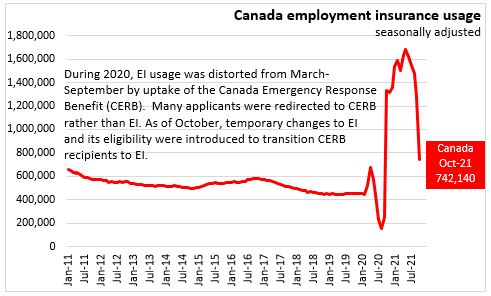
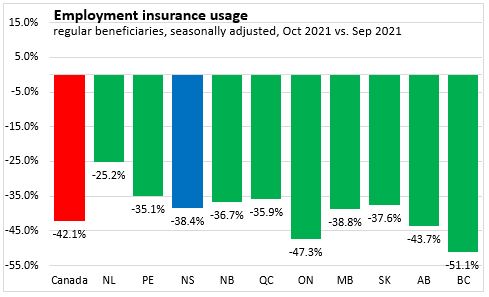
As a percentage of the labour force, employment insurance beneficiaries reflect 7.7% of the labour force in Nova Scotia. Nationally, the share of beneficiaries was 3.6% of the labour force in October. Employment insurance beneficiaries reflect a larger share of the labour force in Atlantic Canada. All provinces reported higher EI proportions than February 2020.
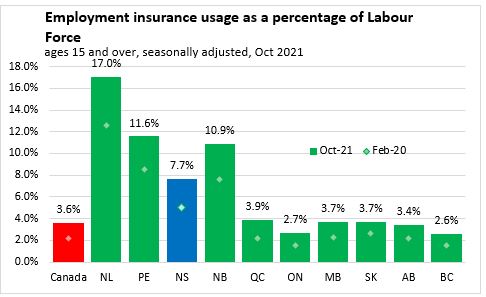
When compared to February 2020, EI usage has increased 66.3% across Canada as of October 2021. In Nova Scotia, EI usage was up 53.0% compared to the pre-pandemic benchmark. The largest percentage increases in EI usage were in Ontario, British Columbia, and Quebec. The smallest increases in EI usage were reported in Prince Edward Island and Newfoundland and Labrador.
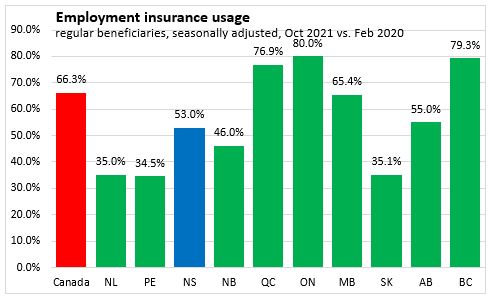
By age and sex cohort, the increase in EI usage has been notably higher among women since the onset of the pandemic (Oct 2021 vs Feb 2020, seasonally adjusted). The industries whose employment was most affected by public health restrictions and other pandemic precautions had a disproportionate share of female employment.
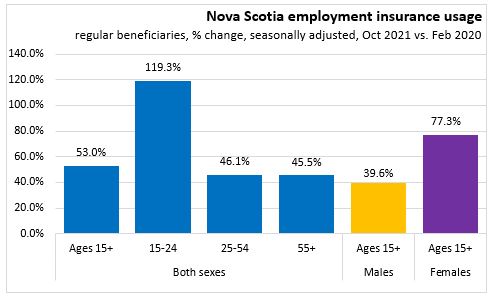

In October 2021, EI beneficiaries reflect a larger share of the labour force for males and for those aged 55 and over.
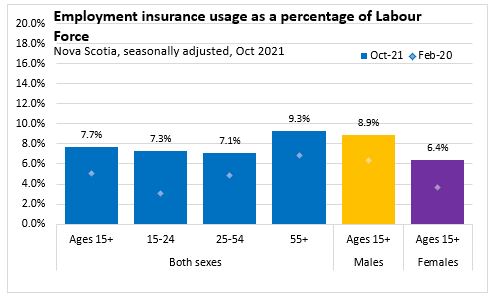
All occupational categories saw increases in EI usage in Nova Scotia for January-October 2021 compared to the same period in 2019. Sales and service occupations reflect the largest number of beneficiaries, and also saw the largest increase in usage compared to before the pandemic. Trades and transportation occupations were the second largest usage category, followed by natural resources and agriculture, manufacturing and utilities, and business, finance and administration.
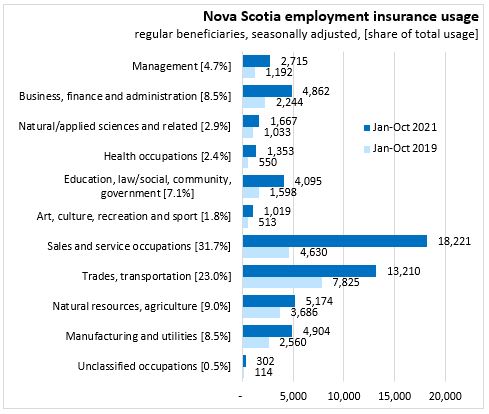
Among counties (comparing unadjusted results for October 2021 with October 2019), EI usage increased the most in Halifax, Queens, Annapolis and Kings counties. Increases in EI usage were lowest in Inverness and Guysborough. The Antigonish county EI recipients estimate for October 2021 is the same as in October 2019.
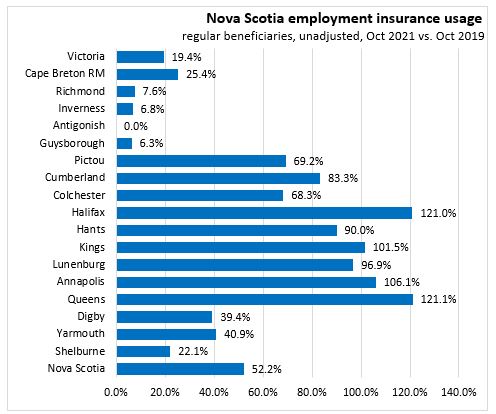

Source: Statistics Canada. Table 14-10-0011-01 Employment insurance beneficiaries (regular benefits) by province and territory, monthly, seasonally adjusted
Table 14-10-0323-01 Employment insurance beneficiaries by census division, monthly, unadjusted for seasonality
Table 14-10-0337-01 Employment insurance beneficiaries (regular benefits) by province, territory and occupation, monthly, seasonally adjusted
Table 14-10-0287-01 Labour force characteristics, monthly, seasonally adjusted and trend-cycle, last 5 months
Table 14-10-0343-01 Employment Insurance beneficiaries by economic region, monthly, unadjusted for seasonality
Table 14-10-0387-01 Labour force characteristics, three-month moving average, unadjusted for seasonality, last 5 months
Table 14-10-0344-01 Employment Insurance beneficiaries (regular benefits) by economic region, monthly, seasonally adjusted
<--- Return to Archive